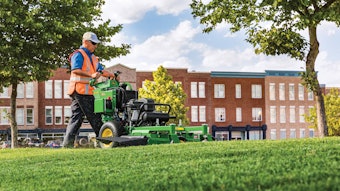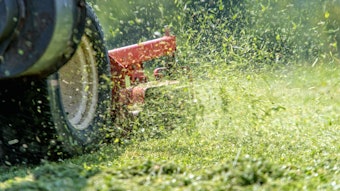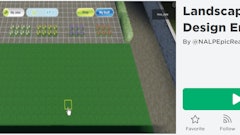Developers and homeowners may begin demanding sustainability in landscape construction and maintenance over the next two to five years. Landscapers who neglect to embrace the sustainability movement could get left behind.
The American Society of Landscape Architects (ASLA), in partnership with the Lady Bird Johnson Wildflower Center at The University of Texas at Austin and the United States Botanic Garden, has developed the Sustainable Sites Initiative (SITES), a proposed national rating system for sustainable landscapes. A diverse group of stakeholder organizations has also been involved, including:
- U.S. Green Building Council (USGBC)
- EPA’s GreenScapes Program
- Professional Landcare Network (PLANET)
- Outdoor Power Equipment Institute (OPEI)
- American Nursery & Landscape Association (ANLA)
- Tree Care Industry Association (TCIA)
- Interlocking Concrete Pavement Institute (ICPI)
SITES Puts Focus on Landscaping
While a number of landscape-related credits already exist under the existing LEED offerings from the USGBC, SITES aims to place considerably more emphasis on landscaping.
For instance, there currently is a LEED credit worth 1-5 points in “Existing Buildings” for limiting or eliminating the use of potable water used for landscape irrigation. “In SITES, it’s a prerequisite that it be reduced by 50% from an established baseline,” says Nancy Somerville, executive vice president and CEO of ASLA. Then, there is a credit worth 2-5 points for reducing it by 75%.
Soil and plant management is another focal point of SITES. “There is currently a LEED credit relating to soil disturbance,” Somerville says. “But the importance of maintaining and/or rebuilding healthy soils and plants is often misunderstood and neglected.” SITES has a soil and vegetation management plan worth up to 51 points.
More Opportunity for Landscapes
Somerville says SITES is modeling itself after the USGBC and how it developed its LEED products. “The USGBC has been a close partner of ours; we’ve had a good exchange of information both ways,” she says.
Somerville believes that much of the SITES work will be incorporated into future versions of LEED. But she also anticipates that SITES will have a stand alone certification system for the types of products that will never be recognized under LEED, because LEED is very building-centric.
“There really is no opportunity for (landscape) projects that don’t have buildings to be part of LEED,” Somerville points out. “That’s the gap SITES is trying to fill.”
The SITES guidelines apply to any type of designed landscape, with or without buildings, ranging from shopping malls, streetscapes, subdivisions, corporate and academic campuses, transportation corridors, parks and recreation areas, all the way to single-family homes.
The Next Step
A two-year pilot project phase is recently underway for SITES. Based on anticipated feedback, Somerville expects that there will need to be some adjustments made to the prerequisites, credits and overall rating system. “Then we’ll have to go through another public comment period.”
PLANET member Richard Heller of Greener by Design in Pelham, NY, believes it will be at least three years before SITES is incorporated into the LEED system or offered as a stand alone rating system. But that doesn’t mean it’s something landscape contractors can continue to ignore.
“The case studies in SITES indicate that although a homeowner may spend 30% more on the landscape installation of a garden following SITES guidelines, the homeowner will get all of that back, if not more, in maintenance savings over time,” Heller points out. The key is for contractors to sell this concept to homeowners.
Developers need to come around, as well. In order for that to happen, they need to see landscape-related elements as sound investments. For example, if a developer needs 40-49 of a possible 110 points for his project to become LEED-certified, he’ll often choose those areas that allow him to accrue the necessary amount of points, while also providing a good ROI.
“Most landscape points, with the exception of green roofs, give low ROI over time in comparison to things like energy-efficient lighting,” Heller points out.
SITES is looking to change that. “Our rating system has 15 prerequisites and 51 credits, 27 of which are based in some way on a credit within the existing LEED for new construction and major renovations or LEED for neighborhood development,” Somerville explains. “In many instances, we’re just trying to take those existing credits above and beyond.”
Proposed Landscape Rating System
The SITES Guidelines and Performance Benchmarks encompass a series of prerequisites and credits for measuring site sustainability. Prerequisites are required. Credits are optional, although a certain number must be attained for a project to achieve eventual recognition as a Sustainable Site.
Rating System for Current Pilot Project Phase (250 possible points)
One Star – 100 points
Two Stars – 125 points
Three Stars – 150 points
Four Stars – 200 points
Index of Prerequisites and Credits
Site Selection (21 possible points) – Select locations to preserve existing resources and repair damaged systems.
Pre-Design Assessment and Planning (4 possible points) – Plan for sustainability from the onset of the project.
Site Design: Water (44 possible points) – Protect and restore processes and systems associated with a site’s hydrology.
Site Design: Soil and Vegetation (51 possible points) – Protect and restore processes and systems associated with a site’s soil and vegetation.
Site Design: Materials Selection (36 possible points) – Reuse/recycle existing materials and support sustainable production practices.
Site Design: Human Health and Well-Being (32 possible points) – Build strong communities and a sense of stewardship.
Construction (21 possible points) – Minimize effects of construction-related activities.
Operations and Maintenance (23 possible points) – Maintain the site for long-term sustainability.
Monitoring and Innovation (18 possible points) – Reward exceptional performance and improve the body of knowledge on long-term sustainability.


























